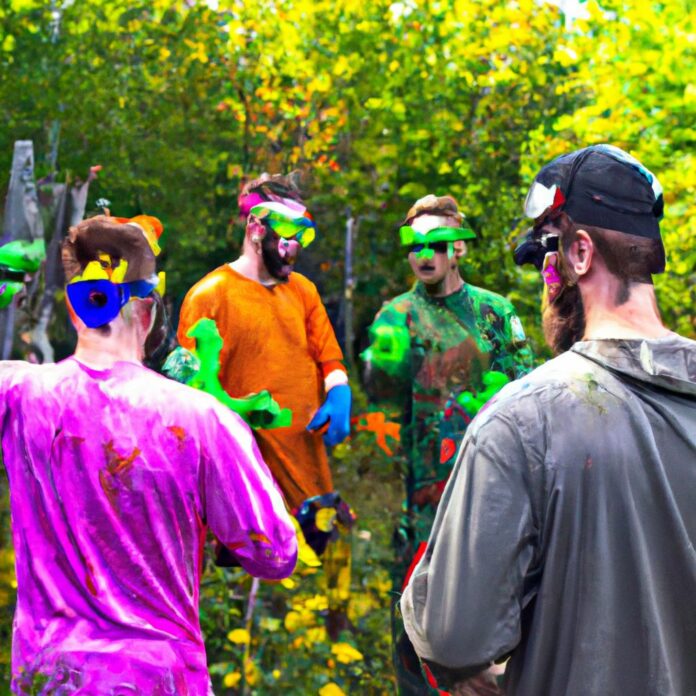Team building activities are essential for fostering collaboration, improving communication, and enhancing overall productivity in a group setting. Among the myriad of team-building activities available, paintball stands out as an exhilarating and effective method of promoting teamwork.
Paintball combines the excitement of a competitive sport with the opportunities for strategic planning and cooperation.
By participating in paintball games, individuals can develop various skills that are vital for effective team building. It fosters communication and collaboration by necessitating constant interaction and coordination with teammates.
Paintball also promotes leadership skills as team members take up different roles and learn to make quick decisions. It enhances problem-solving abilities by putting players in challenging situations that require creative thinking and adaptation.
Paintball builds trust and camaraderie among team members, as they rely on each other for support and backup. Lastly, it develops strategic thinking as individuals analyze the game situation and plan tactics to achieve victory.
To incorporate paintball into team-building activities, certain strategies can be implemented. Setting clear objectives and goals for the games helps focus the team on specific outcomes.
Dividing teams and assigning roles allows individuals to take on different responsibilities and work together towards a common goal. Creating scenarios and challenges that require teamwork and problem-solving enhances the team-building experience.
Finally, facilitating debriefing and reflection sessions after each game allows participants to analyze their performance and identify areas for improvement.
To ensure a successful paintball team-building experience, safety is paramount. Providing proper equipment and ensuring that safety guidelines are followed is essential to prevent injuries.
Promoting fairness and sportsmanship among participants creates a positive and inclusive environment. Encouraging open communication enables effective coordination and collaboration during the games.
Lastly, providing opportunities for team bonding, such as socializing or debriefing sessions, helps strengthen relationships among team members.
How does Paintball Improve Team Building?
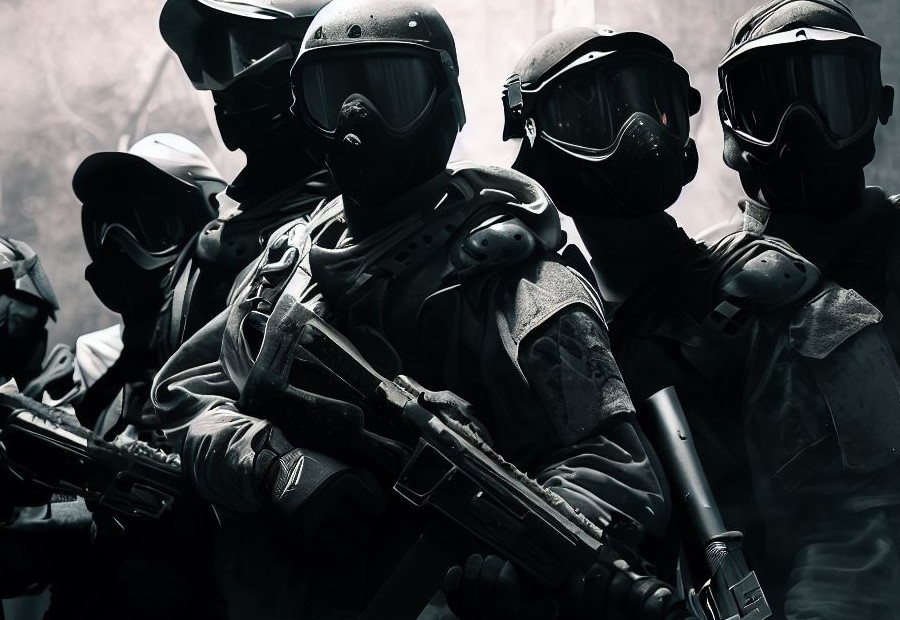
Discover how paintball takes team building to new heights. Uncover its powerful impact on fostering communication, promoting leadership, enhancing problem-solving abilities, building trust and camaraderie, and developing strategic thinking.
Step into the paintball arena and witness a transformative experience that goes beyond mere fun and excitement.
Get ready to unleash your team’s potential and see firsthand how paintball can revolutionize team dynamics.
Fosters Communication and Collaboration
Fostering communication and collaboration is a crucial aspect of paintball when it comes to team building. The fast-paced nature of the game requires constant communication between team members to strategize and coordinate their movements on the field.
Teams must work together to devise effective plans, share information about the opponents’ positions, and communicate their own positions to avoid friendly fire. This enhances collaboration and forces team members to rely on each other to achieve victory.
Moreover, paintball nurtures communication and collaboration beyond the battlefield. During the game, teammates learn to trust and rely on each other, building a stronger bond and sense of camaraderie. This translates into improved teamwork and cohesion in other aspects of work or personal life.
By participating in team-building activities like paintball, individuals develop essential communication skills such as active listening, effective verbal and non-verbal communication, and quick decision-making.
These skills are transferable to a professional setting, leading to better collaboration, problem-solving, and overall team performance.
Therefore, paintball not only provides an adrenaline-filled experience but also cultivates effective communication and collaboration skills that are vital in any team environment.
Paintball was invented in the early 1980s by Charles Gaines and Bob Gurnsey, who were seeking a way to recreate the excitement and adrenaline rush of a real-life combat scenario.
Originally, the game was played using Nel-Spot pistols, which were used by foresters to mark trees and livestock.
The first organized game of paintball took place in 1981, with twelve players split into two teams. Since then, the sport has grown tremendously in popularity and has become a popular activity for team-building exercises and recreational purposes alike.
Promotes Leadership Skills
The paintball activity promotes leadership skills in team building through:
- Assigning team leaders: Paintball provides the opportunity to assign individuals as team leaders, enabling them to take charge and make decisions for their team.
- Strategic planning: Leaders in paintball need to analyze the situation, assess the strengths and weaknesses of their team and the opponents, and devise a winning strategy.
- Effective communication: Leaders must effectively communicate their plans, strategies, and instructions to their team members during the intense and fast-paced game.
- Decision-making under pressure: Paintball requires leaders to make quick decisions in high-pressure situations, leading their team towards victory.
- Team coordination: Leaders play a crucial role in coordinating the efforts of their team members, ensuring everyone is working together towards a common goal.
Enhances Problem-Solving Abilities
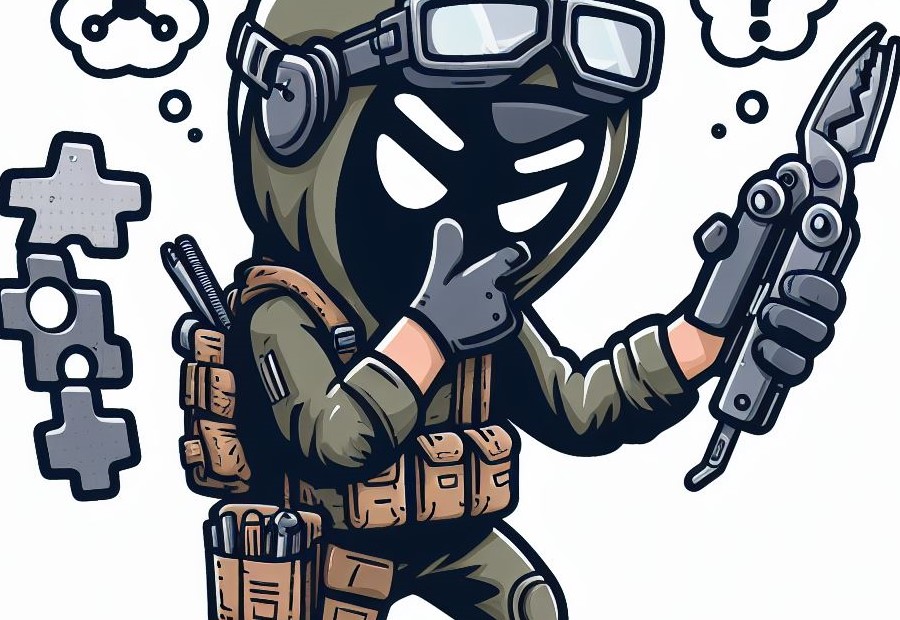
Paintball is an activity that significantly boosts problem-solving abilities by presenting teams with challenging scenarios that necessitate critical thinking and strategic planning.
In order to achieve their objectives, teams must carefully assess the situation, devise effective strategies, and promptly make decisions. The high-pressure environment of paintball compels individuals to think quickly and innovatively to overcome obstacles.
The process of problem-solving in paintball is dynamic and multifaceted, involving the evaluation of various options, adaptability to evolving circumstances, and collaborative efforts with teammates.
Through participating in this experience, individuals cultivate their creative thinking skills and develop the ability to think outside the box, enabling them to outsmart opponents and successfully accomplish their goals.
Additionally, paintball fosters teamwork and communication among players, as they must proficiently communicate their ideas, share crucial information, and synchronize their actions with their teammates to solve complex challenges.
Through collaborative efforts, individuals gain a deep appreciation for the importance of teamwork and experience the power of collective problem-solving.
Builds Trust and Camaraderie
This sub-topic emphasizes the positive impact of paintball on team dynamics. Here are the ways in which paintball fosters trust and camaraderie:
- Encourages Effective Communication: Paintball necessitates effective communication among players to strategize and coordinate their movements. This promotes open communication and strengthens the bond between teammates.
- Fosters Collaboration: In order to succeed in paintball, teams must collaborate towards a common goal. This fosters a sense of collaboration and helps team members trust and rely on each other.
- Develops Camaraderie: Sharing the paintball experience creates a sense of camaraderie among team members. The shared challenges and victories build a sense of unity and camaraderie within the team.
- Builds Trust: Paintball requires teammates to trust one another to have each other’s backs and make strategic decisions. Through shared experiences and relying on each other during the game, trust is strengthened among team members.
Develops Strategic Thinking
Paintball cultivates the development of strategic thinking skills in participants. Strategic thinking entails the ability to analyze situations, foresee outcomes, and make well-informed decisions in order to accomplish specific objectives.
In the midst of a paintball game, players must skillfully strategize their movements, evaluate the positions of their adversaries, and formulate tactics to outwit them. This necessitates contemplating multiple steps in advance and considering various potential scenarios.
Moreover, players must be flexible and adjust their strategies on the spot as the game unfolds.
Participating in paintball allows individuals to nurture their strategic thinking abilities. They learn to assess the battlefield, identify advantageous opportunities and potential risks, and devise effective strategies to secure triumph.
Consequently, this fosters critical thinking skills and enhances proficiency in decision-making.
Strategic thinking in paintball also encompasses the principles of teamwork and collaboration. Players must synchronize their efforts with their teammates, communicate strategies, and execute coordinated maneuvers.
This fosters effective communication and augments collaboration skills, as each team member contributes their own strategic insights.
How to Incorporate Paintball into Team-Building Activities?
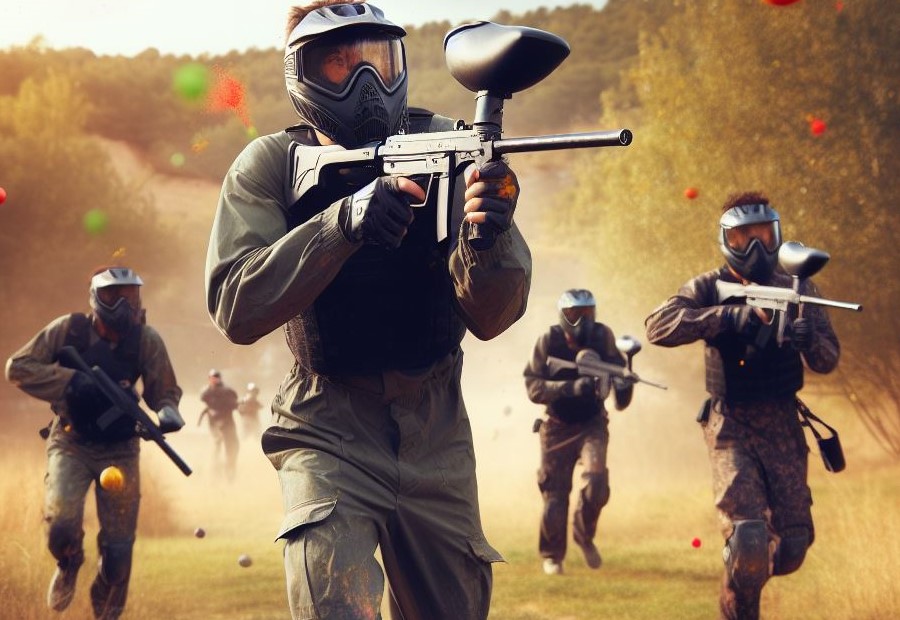
Looking to incorporate paintball into team-building activities? Get ready to level up your team’s dynamics with these essential strategies. From setting objectives and dividing teams to creating challenging scenarios, we’ll guide you through the process.
And don’t miss our tips for facilitating debriefing and reflection to ensure maximum growth. Let’s dive in and explore the thrilling world of paintball as a catalyst for building stronger, more united teams.
Setting Objectives and Goals
When incorporating paintball into team-building activities, setting objectives and goals is a crucial step to ensure a successful experience.
Here are the steps to follow:
- Identify the desired outcomes: Determine what specific skills or attributes you want to develop in your team through the paintball activity. It could be improved communication, teamwork, leadership, problem-solving, or strategic thinking.
- Create SMART objectives: Set specific, measurable, achievable, relevant, and time-bound objectives that align with the desired outcomes.
- Communicate the objectives to the team: Clearly explain the objectives and their importance to the team. Ensure everyone understands what they need to achieve and how it contributes to overall team development.
- Develop an action plan: Break down the objectives into actionable tasks and assign responsibilities to team members. Outline specific strategies and tactics to achieve the objectives.
- Monitor progress: Regularly assess the team’s performance and progress towards the objectives. Provide feedback and guidance to ensure everyone stays on track.
- Adjust and refine: If necessary, make adjustments to the objectives or action plan based on the team’s performance and feedback. Continuously refine the goals to keep them challenging yet attainable.
Pro-tip: Celebrate the achievement of objectives by recognizing and rewarding the team’s efforts. This fosters motivation and encourages continuous improvement.
Dividing Teams and Assigning Roles
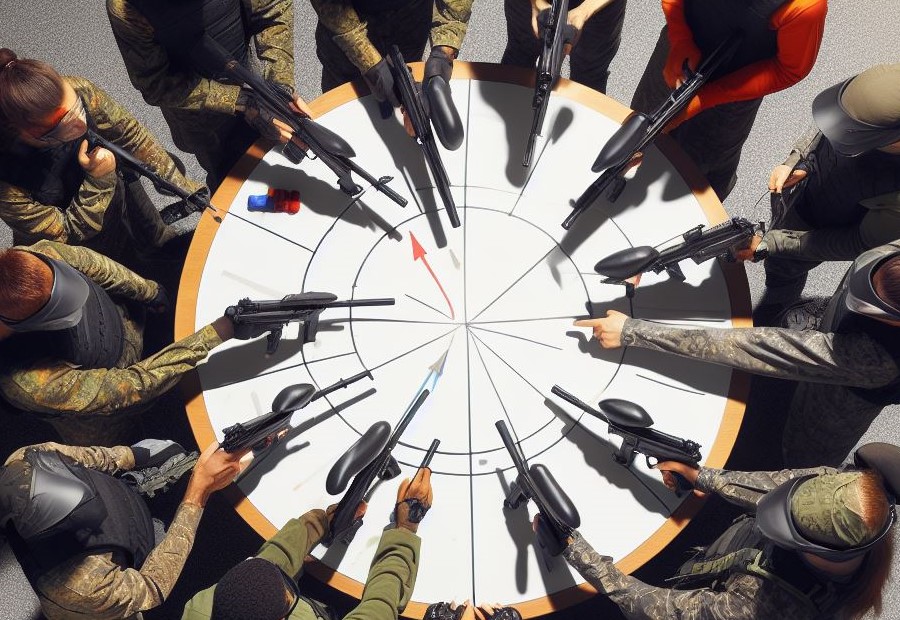
Dividing teams and assigning roles is a crucial aspect of incorporating paintball into team-building activities. When dividing teams, it is important to consider team dynamics, including the participants’ skill levels, experience, and personalities.
Strive for a balance of strengths and weaknesses to promote teamwork and healthy competition.
- Consider team dynamics: When dividing teams, take into account the participants’ skill levels, experience, and personalities. Strive for a balance of strengths and weaknesses to promote teamwork and healthy competition.
- Assign specific roles: Designate roles such as team leader, strategists, and communication coordinators. This encourages each team member to take on responsibilities and contribute to the overall success of the team.
- Promote collaboration: Encourage team members to work together and communicate effectively by assigning tasks that require cooperation. This fosters a sense of unity and shared goals within the team.
- Create a supportive environment: Ensure that team members understand that their roles are essential and valued. Emphasize that success depends on the collective effort and encourage mutual support and respect.
- Rotate roles: To cultivate versatility and enhance team dynamics, consider rotating roles throughout different scenarios or sessions. This allows team members to experience different perspectives and develop a comprehensive understanding of team dynamics.
Pro-tip: Regularly assess the effectiveness of the team’s roles and make adjustments if necessary. This ensures that each team member has a meaningful contribution and that the division of teams and roles remains relevant to the team-building objectives.
Creating Scenarios and Challenges
Creating scenarios and challenges is a crucial aspect of incorporating paintball into team-building activities. It provides opportunities for teams to work together, strategize, and overcome obstacles in a simulated environment.
- Design diverse scenarios: Craft scenarios that require different skills and approaches. This could include capturing a flag, defending a position, or rescuing a team member. Varying scenarios ensures teams can showcase their strengths and areas for improvement.
- Set goals: Clearly define objectives for each scenario. Whether it’s achieving a specific target, completing a mission within a set time, or eliminating all opponents, goals provide teams with focus and motivation.
- Introduce challenges: Add elements that will challenge teams during scenarios. This could involve limited ammunition, restricted visibility, or additional obstacles. Challenges test teams’ adaptability, decision-making, and teamwork under pressure.
- Encourage teamwork: Establish scenarios that require coordination and cooperation among team members. Encourage effective communication, delegation of tasks, and supporting one another. This fosters a sense of unity and reinforces the importance of collaboration.
- Provide opportunities for reflection: After each scenario, facilitate a debriefing session to reflect on the team’s performance. Discuss strengths, weaknesses, and strategies that worked well or need improvement. This reflection encourages continuous learning and growth.
Pro-tip: To ensure an engaging experience, rotate the team roles and scenarios for each session to provide variety and prevent complacency.
Facilitating Debriefing and Reflection
Facilitating debriefing and reflection is a vital aspect of utilizing paintball as a team-building activity.
It is crucial in allowing team members to assess their performance, identify their strengths and weaknesses, and learn from their experiences.
In the process of debriefing, it is important for team leaders or facilitators to establish a safe and open environment where participants can freely share their thoughts and emotions.
This can be achieved by encouraging active participation and fostering non-judgmental listening.
Reflection plays a significant role in helping individuals comprehend their own actions and the impact they have had on the overall performance of the team. It also provides an opportunity for individuals to receive constructive feedback from their peers and leaders, enabling personal growth and improvement.
By facilitating debriefing and reflection, teams can gain valuable insights into their communication skills, decision-making processes, and strategies. They can effectively identify areas of excellence as well as areas that require improvement.
Throughout history, debriefing and reflection have been successfully implemented in numerous fields, including the military and aviation industry.
These practices have proven to be effective in enhancing performance, analyzing outcomes, and making necessary adjustments for future success.
By incorporating these practices into paintball team-building activities, organizations can optimize the benefits and create a more cohesive and efficient team.
Tips for a Successful Paintball Team-Building Experience
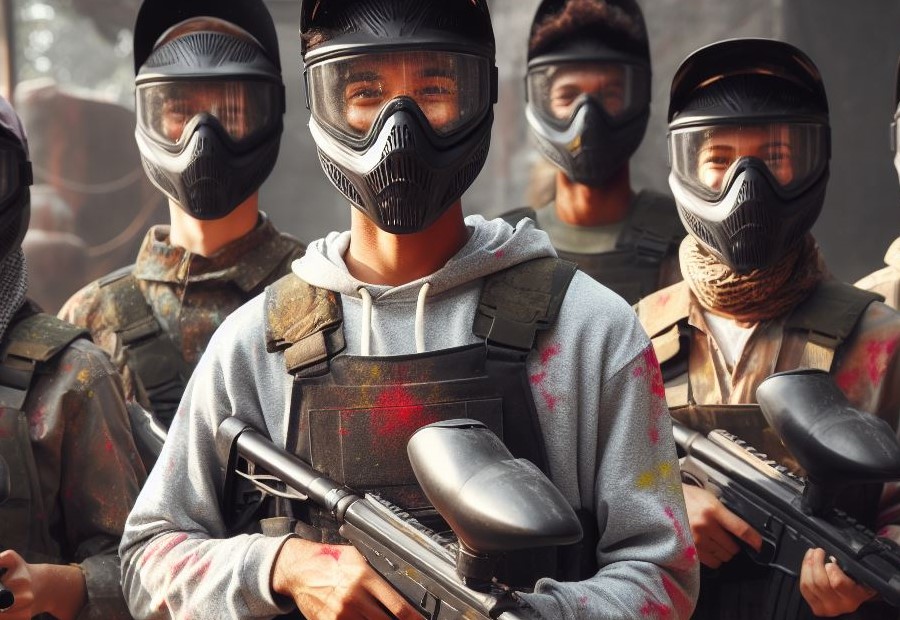
Looking to have a successful paintball team-building experience? Here are some essential tips to keep in mind. Safety and proper equipment, fairness and sportsmanship, open communication, and team bonding opportunities are the key ingredients.
So, gear up, communicate openly, and get ready to bond with your team on the paintball field!
Ensure Safety and Proper Equipment
Ensuring safety and proper equipment is crucial for a successful paintball team-building experience. It is important to prioritize safety and make sure all participants have the necessary equipment and follow the proper guidelines.
Follow these steps to ensure the safety and well-being of everyone involved:
- Make sure to provide safety goggles or masks for each participant. These protective gear will safeguard their eyes from potential injuries.
- Ensure that all participants are wearing appropriate clothing, such as long pants and long-sleeved shirts. This will help protect their skin from bruises or scratches during the game.
- Regularly inspect and maintain paintball markers to ensure they are in good working condition. This will help prevent any accidents or safety risks.
- Prior to starting the game, establish clear safety rules and guidelines. Make sure all participants fully understand and follow them. It is vital that everyone is aware of the safety measures in place.
- Designate a trained and experienced referee or game marshal. They will be responsible for monitoring the activity and intervening if any safety violations occur. Having someone who can handle any safety concerns is essential.
- Always have first aid kits readily available. In case of any injuries, there should be a designated area for medical assistance. Prompt and proper medical attention is crucial in ensuring the well-being of all participants.
- Before starting the game, ensure that the playing field is free from any potential hazards or obstacles that could cause accidents. It is important to thoroughly inspect the area and remove any potential dangers.
- Communicate and emphasize the importance of sportsmanship and fair play to all participants. Promoting a respectful and safe environment is key to creating an enjoyable and secure paintball team-building experience.
By following these steps, you can effectively ensure the safety of all participants and create an enjoyable and secure paintball team-building experience.
Promote Fairness and Sportsmanship
Promoting fairness and sportsmanship is crucial in paintball team-building activities. To ensure a positive experience, teams should actively promote fairness and sportsmanship, adhering to rules and demonstrating integrity.
Fairness can be promoted by enforcing equal opportunities, such as limiting the use of equipment or setting time limits for certain tasks. Sportsmanship involves displaying respect for opponents, accepting defeat gracefully, and celebrating victories modestly.
It is important to encourage fair play and respect, as it not only fosters a healthy competitive environment but also cultivates positive teamwork skills.
Encourage Open Communication
Encouraging open communication is crucial in paintball team-building activities as it promotes collaboration, problem-solving, and trust among team members.
- By actively encouraging open communication, team members can freely share their thoughts, ideas, and strategies during the game. This allows for a more inclusive and collaborative approach to decision-making.
- Open communication enables team members to give and receive constructive feedback. It provides an opportunity for continuous improvement and learning from each other’s experiences.
- Clear and open communication during gameplay is essential for coordinating movements, planning strategies, and ensuring the safety and success of the team. Communicating effectively can help avoid confusion and misunderstandings.
- Open communication creates a safe space for team members to express any concerns or address conflicts that may arise during the game. By openly addressing and resolving conflicts, trust and camaraderie within the team can be fostered.
- Through open communication, team members can provide support and motivation to one another, boosting team morale and cohesion. This can ultimately lead to improved teamwork and better performance.
Encouraging open communication in paintball team-building activities can greatly enhance the overall effectiveness of the team, leading to better collaboration, problem-solving, and trust among team members.
Provide Opportunities for Team Bonding
Paintball provides the perfect opportunity for teams to participate in various team-building exercises, thereby providing opportunities for team bonding.
It involves working together, strategizing, and coordinating their actions to achieve a common goal and encourages communication and collaboration among team members.
By playing paintball, team members learn to trust and rely on each other, promoting trust and camaraderie.
Additionally, paintball presents teams with challenging scenarios that require problem-solving skills, helping team members develop their ability to think critically and find solutions under pressure, as well as build resilience and adaptability.
Paintball’s rich history and its evolution into a competitive sport make it an effective choice for organizations seeking to enhance team bonding and collaboration.
Frequently Asked Questions
How does paintball help in team building?
Paintball helps in team building by providing a competitive game that requires strong leadership skills, effective communication, and group coordination.
It promotes teamwork and the pursuit of common objectives, helping team members develop hidden skills and work together to achieve success.
What safety gears are provided for participants in paintball team building activities?
Participants in paintball team building activities are equipped with a paintball face mask and a paintball marker that uses water-soluble paintballs. These safety gears ensure the protection of the participants during the game.
Is paintball a competitive game?
Yes, paintball is a competitive game played to win, similar to tag, hide-and-seek, or capture the flag. It requires strategic planning, effective decision-making, and the ability to think two moves ahead to outplay the opposing team and achieve victory.
How does paintball help in relieving stress and improving productivity?
Paintball helps in relieving stress by providing a fun and physical activity that releases endorphins, reducing stress levels and providing a break from work.
This, in turn, increases motivation and productivity when team members return to their tasks with a refreshed mindset.
What are the benefits of mixing teams during paintball team building activities?
Mixing teams during paintball team building activities creates a competitive yet fun environment for everyone to enjoy.
It encourages individuals to interact and collaborate with different team members, promoting diversity and strengthening relationships within the organization.
Is paintball suitable for people of any age?
Yes, paintball is suitable for people of any age. Paintball events provide age-appropriate activities for corporations, families, and friends. Safety equipment and professional supervision ensure that all participants can engage in the game safely and enjoyably.

